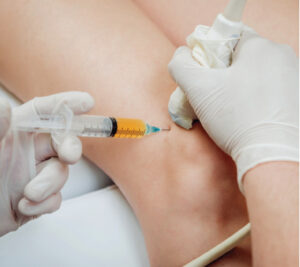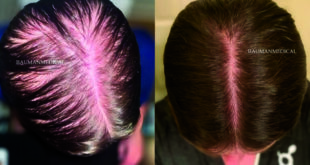 Platelet-rich plasma (PRP) therapy has become a game-changer in regenerative medicine, offering a natural, non-invasive treatment option to accelerate healing and reduce pain for various musculoskeletal conditions. However, the success of PRP treatments heavily relies on one crucial factor: precision. Enter ultrasound guidance—an advanced imaging technique that enhances the accuracy, safety, and efficacy of PRP treatments. Here’s why integrating ultrasound guidance into PRP therapy is not just a luxury but a necessity.
Platelet-rich plasma (PRP) therapy has become a game-changer in regenerative medicine, offering a natural, non-invasive treatment option to accelerate healing and reduce pain for various musculoskeletal conditions. However, the success of PRP treatments heavily relies on one crucial factor: precision. Enter ultrasound guidance—an advanced imaging technique that enhances the accuracy, safety, and efficacy of PRP treatments. Here’s why integrating ultrasound guidance into PRP therapy is not just a luxury but a necessity.
The Foundation of PRP Therapy
PRP therapy works by harnessing the body’s healing potential. A sample of the patient’s blood is processed to concentrate platelets, which are rich in growth factors and can recognize damaged tissue. These growth factors stimulate tissue repair and enhance recovery, showing benefits in pain and function in conditions such as knee arthritis, rotator cuff tears, as well as the spinal pain conditions.
However, the effectiveness of PRP depends on delivering the concentrated platelets precisely to the injured area. This is where ultrasound guidance comes into play.
The Challenge of Blind Injections
Traditionally, injections were administered using palpation techniques or anatomical landmarks, often referred to as “blind injections.” While experienced practitioners can achieve decent results with this method, it leaves much to chance, particularly when targeting deep or hard-to-locate structures.
Blind injections pose several risks, including:
Inaccurate Delivery: Without visual confirmation, the PRP may miss the intended target, diluting its therapeutic potential.
Increased Pain: Misplaced injections can cause unnecessary pain or discomfort for the patient.
Complications: Inadvertently injecting nearby structures such as nerves
Given these limitations, a precise approach is imperative to maximize the benefits of PRP therapy.
Ultrasound Guidance: Redefining Precision
Ultrasound guidance transforms PRP treatments into a precise, visualized procedure. Using real-time imaging, clinicians can visualize the target tissue, surrounding structures, and the needle’s trajectory. This approach significantly enhances the accuracy of PRP delivery, ensuring optimal results.
Key Advantages of Ultrasound Guidance
Enhanced Accuracy With ultrasound, clinicians can locate the exact site of injury or degeneration, whether it’s a small tendon tear or a specific joint capsule. This ensures that the PRP is deposited precisely where it is needed, maximizing its effects.
Improved Safety Real-time imaging allows practitioners to avoid critical structures such as nerves, arteries, and veins, minimizing the risk of complications. This is especially crucial for delicate areas like the spine or wrist.
Better Outcomes By ensuring accurate delivery of PRP, ultrasound guidance enhances the treatment’s effectiveness. Studies show that image-guided injections consistently outperform blind injections in terms of pain relief, functional improvement, and patient satisfaction.
Reduced Patient Discomfort Precise needle placement reduces the number of attempts and tissue trauma, making the procedure more comfortable for the patient. This also contributes to quicker recovery times.
Customization and Flexibility Ultrasound enables real-time adjustments during the procedure. Doctors can assess tissue response and modify their approach as needed, tailoring the treatment to each patient’s unique anatomy and condition.
Clinical Applications of Ultrasound-Guided PRP Treatments
The versatility of ultrasound guidance makes it applicable across a wide range of conditions, including:
Tendon Injuries: Conditions like tennis elbow, Achilles tendinitis, and rotator cuff injuries benefit from precise PRP delivery to the damaged tendon fibers.
Joint Osteoarthritis: Injections into the joint space, such as the knee or hip, are more effective when guided by ultrasound, ensuring accurate placement within the joint capsule.
Ligament Tears: Partial ligament tears, such as those in the ankle or knee, require targeted PRP delivery to stimulate repair and strengthen the structure.
Muscle Tears: Ultrasound helps identify the exact location of muscle damage, allowing plasma to be injected directly into the affected area.
Nerve Entrapments: In complex cases like carpal tunnel syndrome, ultrasound ensures that PRP is delivered precisely to the area of nerve compression.
Patient Experience and Confidence
For patients, the use of ultrasound guidance provides an added layer of confidence. Seeing the real-time imaging during the procedure reassures them that the treatment is both precise and personalized. Moreover, the reduced discomfort and improved outcomes associated with ultrasound-guided injections enhance overall patient satisfaction.
The Evidence Speaks for Itself
Scientific studies consistently highlight the superiority of ultrasound-guided injections over blind techniques.
For instance:
A study published in The American Journal of Sports Medicine found that ultrasound-guided PRP injections for rotator cuff tendinopathy resulted in significantly better pain relief and functional improvement compared to blind injections.
Research in Arthroscopy: The Journal of Arthroscopic & Related Surgery demonstrated that ultrasound guidance improved the accuracy of intra-articular injections by up to 95%.
These findings underscore the importance of ultrasound as an indispensable tool in PRP therapy.
Conclusion: A Gold Standard in PRP Therapy
Ultrasound guidance has revolutionized the way PRP injections are performed, setting a new standard in regenerative medicine. Its ability to enhance accuracy, safety, and patient outcomes makes it an essential component of modern PRP therapy.
If you’re considering PRP therapy, ensure that your provider is an expert in the use of ultrasound guidance—it’s the key to unlocking the full potential of regenerative medicine. Your health deserves nothing less than precision, safety, and success.
woz wellness
844-GO PROLO (844-467-7656)
www.wozwellness.com
 South Florida Health and Wellness Magazine Health and Wellness Articles
South Florida Health and Wellness Magazine Health and Wellness Articles




